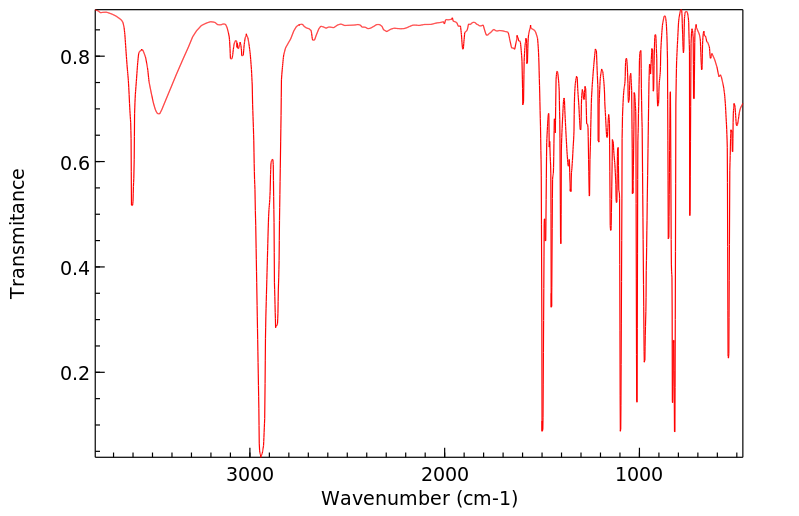1-对氯苯基-1-环己醇 | 17380-83-5
中文名称
1-对氯苯基-1-环己醇
中文别名
1-P-氯苯基-1-环己醇
英文名称
1-(4-chlorophenyl)cyclohexanol
英文别名
1-(4-chlorophenyl)cyclohexan-1-ol
CAS
17380-83-5
化学式
C12H15ClO
mdl
——
分子量
210.704
InChiKey
WSXSGCNVGCTIIZ-UHFFFAOYSA-N
BEILSTEIN
——
EINECS
——
-
物化性质
-
计算性质
-
ADMET
-
安全信息
-
SDS
-
制备方法与用途
-
上下游信息
-
文献信息
-
表征谱图
-
同类化合物
-
相关功能分类
-
相关结构分类
计算性质
-
辛醇/水分配系数(LogP):3.3
-
重原子数:14
-
可旋转键数:1
-
环数:2.0
-
sp3杂化的碳原子比例:0.5
-
拓扑面积:20.2
-
氢给体数:1
-
氢受体数:1
安全信息
-
海关编码:2906299090
SDS
上下游信息
反应信息
-
作为反应物:描述:参考文献:名称:铜/Selectfluor 系统催化的叔环醇脱水氧化:获得 β-取代的 Cyclohex-2-enones、4-Arylcoumarins 和 Biaryls摘要:β-取代的环己-2-烯酮、4-芳基香豆素和联芳基的路线已经开发出来。这种方法涉及一锅 CuO/Selectfluor 催化的叔环醇脱水氧化。因此,通过使用 2 equiv。Selectfluor 在 25 °C 下,叔环己醇和氧杂苯并环己醇的脱水-氧化分别得到 β-取代的环己-2-烯酮和 4-芳基香豆素;而叔环己醇的脱水-氧化使用 2.5 当量得到联芳基化合物作为最终产物。Selectfluor 在 80 °C。DOI:10.1002/ejoc.201500610
-
作为产物:描述:在 air 作用下, 以 二氯甲烷 为溶剂, 反应 16.0h, 以82.2 mg的产率得到1-对氯苯基-1-环己醇参考文献:名称:通过恶二唑啉向不稳定的重氮化合物的通用途径及其在芳烷基交叉偶联反应中的用途。摘要:作为一种有效的无金属碳-碳键形成方法,最近出现了易于获得的硼酸和重氮化合物的偶联。然而,迄今为止,以温和的方式形成不稳定的重氮化合物伴侣的困难限制了它们的一般用途和转化范围。在这里,我们报道了恶二唑啉作为前体的应用,它使用流式紫外光解法生成不稳定的重氮化合物家族,并首次用于不同的原去硼和氧化C(sp2)-C(sp3)交叉偶联过程中,具有出色的功能组容忍度。DOI:10.1002/anie.201710445
文献信息
-
Reaction of Grignard reagents with carbonyl compounds under continuous flow conditions作者:E. Riva、S. Gagliardi、M. Martinelli、D. Passarella、D. Vigo、A. RencurosiDOI:10.1016/j.tet.2010.02.078日期:2010.4This contribution details how a continuous flow reactor was used to react carbonyl compounds with Grignard reagents at room temperature in an efficient and safe manner. Flow rate, residence time and temperature were optimized for the preparation of a small collection of secondary and tertiary alcohols. Excellent yields and general applicability were observed using the set-up protocol. The procedure
-
Oxidative α-C–C Bond Cleavage of 2° and 3° Alcohols to Aromatic Acids with O<sub>2</sub> at Room Temperature via Iron Photocatalysis作者:Zongnan Zhang、Guoxiang Zhang、Ni Xiong、Ting Xue、Junjie Zhang、Lu Bai、Qinyue Guo、Rong ZengDOI:10.1021/acs.orglett.1c00556日期:2021.4.16cleavage of unfunctionalized secondary (2°) and tertiary alcohols (3°) is essential for valorization of macromolecules and biopolymers. We developed a blue-light-driven iron catalysis for aerobic oxidation of 2° and 3° alcohols to acids via α-C–C bond cleavages at room temperature. The first example of oxygenation of the simple tertiary alcohols was reported. The iron catalyst and blue light play critical
-
Iron-Catalyzed C–C Single-Bond Cleavage of Alcohols作者:Wei Liu、Qiang Wu、Miao Wang、Yahao Huang、Peng HuDOI:10.1021/acs.orglett.1c03137日期:2021.11.5An iron-catalyzed deconstruction/hydrogenation reaction of alcohols through C–C bond cleavage is developed through photocatalysis, to produce ketones or aldehydes as the products. Tertiary, secondary, and primary alcohols bearing a wide range of substituents are suitable substrates. Complex natural alcohols can also perform the transformation selectively. A investigation of the mechanism reveals a
-
Triphosgene and DMAP as Mild Reagents for Chemoselective Dehydration of Tertiary Alcohols作者:Moshood O. Ganiu、Alexander H. Cleveland、Jarrod L. Paul、Rendy KartikaDOI:10.1021/acs.orglett.9b01959日期:2019.7.19The utility of triphosgene and DMAP as mild reagents for chemoselective dehydration of tertiary alcohols is reported. Performed in dichloromethane at room temperature, this reaction is readily tolerated by a broad scope of substrates, yielding alkenes preferentially with the (E)-geometry. While formation of the Hofmann products is generally favored, a dramatic change in alkene selectivity toward the
-
一种联苯类化合物的合成方法
表征谱图
-
氢谱1HNMR
-
质谱MS
-
碳谱13CNMR
-
红外IR
-
拉曼Raman
-
峰位数据
-
峰位匹配
-
表征信息
同类化合物
(βS)-β-氨基-4-(4-羟基苯氧基)-3,5-二碘苯甲丙醇
(S,S)-邻甲苯基-DIPAMP
(S)-(-)-7'-〔4(S)-(苄基)恶唑-2-基]-7-二(3,5-二-叔丁基苯基)膦基-2,2',3,3'-四氢-1,1-螺二氢茚
(S)-盐酸沙丁胺醇
(S)-3-(叔丁基)-4-(2,6-二甲氧基苯基)-2,3-二氢苯并[d][1,3]氧磷杂环戊二烯
(S)-2,2'-双[双(3,5-三氟甲基苯基)膦基]-4,4',6,6'-四甲氧基联苯
(S)-1-[3,5-双(三氟甲基)苯基]-3-[1-(二甲基氨基)-3-甲基丁烷-2-基]硫脲
(R)富马酸托特罗定
(R)-(-)-盐酸尼古地平
(R)-(-)-4,12-双(二苯基膦基)[2.2]对环芳烷(1,5环辛二烯)铑(I)四氟硼酸盐
(R)-(+)-7-双(3,5-二叔丁基苯基)膦基7''-[((6-甲基吡啶-2-基甲基)氨基]-2,2'',3,3''-四氢-1,1''-螺双茚满
(R)-(+)-7-双(3,5-二叔丁基苯基)膦基7''-[(4-叔丁基吡啶-2-基甲基)氨基]-2,2'',3,3''-四氢-1,1''-螺双茚满
(R)-(+)-7-双(3,5-二叔丁基苯基)膦基7''-[(3-甲基吡啶-2-基甲基)氨基]-2,2'',3,3''-四氢-1,1''-螺双茚满
(R)-(+)-4,7-双(3,5-二-叔丁基苯基)膦基-7“-[(吡啶-2-基甲基)氨基]-2,2”,3,3'-四氢1,1'-螺二茚满
(R)-3-(叔丁基)-4-(2,6-二苯氧基苯基)-2,3-二氢苯并[d][1,3]氧杂磷杂环戊烯
(R)-2-[((二苯基膦基)甲基]吡咯烷
(R)-1-[3,5-双(三氟甲基)苯基]-3-[1-(二甲基氨基)-3-甲基丁烷-2-基]硫脲
(N-(4-甲氧基苯基)-N-甲基-3-(1-哌啶基)丙-2-烯酰胺)
(5-溴-2-羟基苯基)-4-氯苯甲酮
(5-溴-2-氯苯基)(4-羟基苯基)甲酮
(5-氧代-3-苯基-2,5-二氢-1,2,3,4-oxatriazol-3-鎓)
(4S,5R)-4-甲基-5-苯基-1,2,3-氧代噻唑烷-2,2-二氧化物-3-羧酸叔丁酯
(4S,4''S)-2,2''-亚环戊基双[4,5-二氢-4-(苯甲基)恶唑]
(4-溴苯基)-[2-氟-4-[6-[甲基(丙-2-烯基)氨基]己氧基]苯基]甲酮
(4-丁氧基苯甲基)三苯基溴化磷
(3aR,8aR)-(-)-4,4,8,8-四(3,5-二甲基苯基)四氢-2,2-二甲基-6-苯基-1,3-二氧戊环[4,5-e]二恶唑磷
(3aR,6aS)-5-氧代六氢环戊基[c]吡咯-2(1H)-羧酸酯
(2Z)-3-[[(4-氯苯基)氨基]-2-氰基丙烯酸乙酯
(2S,3S,5S)-5-(叔丁氧基甲酰氨基)-2-(N-5-噻唑基-甲氧羰基)氨基-1,6-二苯基-3-羟基己烷
(2S,2''S,3S,3''S)-3,3''-二叔丁基-4,4''-双(2,6-二甲氧基苯基)-2,2'',3,3''-四氢-2,2''-联苯并[d][1,3]氧杂磷杂戊环
(2S)-(-)-2-{[[[[3,5-双(氟代甲基)苯基]氨基]硫代甲基]氨基}-N-(二苯基甲基)-N,3,3-三甲基丁酰胺
(2S)-2-[[[[[((1S,2S)-2-氨基环己基]氨基]硫代甲基]氨基]-N-(二苯甲基)-N,3,3-三甲基丁酰胺
(2S)-2-[[[[[[((1R,2R)-2-氨基环己基]氨基]硫代甲基]氨基]-N-(二苯甲基)-N,3,3-三甲基丁酰胺
(2-硝基苯基)磷酸三酰胺
(2,6-二氯苯基)乙酰氯
(2,3-二甲氧基-5-甲基苯基)硼酸
(1S,2S,3S,5S)-5-叠氮基-3-(苯基甲氧基)-2-[(苯基甲氧基)甲基]环戊醇
(1S,2S,3R,5R)-2-(苄氧基)甲基-6-氧杂双环[3.1.0]己-3-醇
(1-(4-氟苯基)环丙基)甲胺盐酸盐
(1-(3-溴苯基)环丁基)甲胺盐酸盐
(1-(2-氯苯基)环丁基)甲胺盐酸盐
(1-(2-氟苯基)环丙基)甲胺盐酸盐
(1-(2,6-二氟苯基)环丙基)甲胺盐酸盐
(-)-去甲基西布曲明
龙蒿油
龙胆酸钠
龙胆酸叔丁酯
龙胆酸
龙胆紫-d6
龙胆紫







